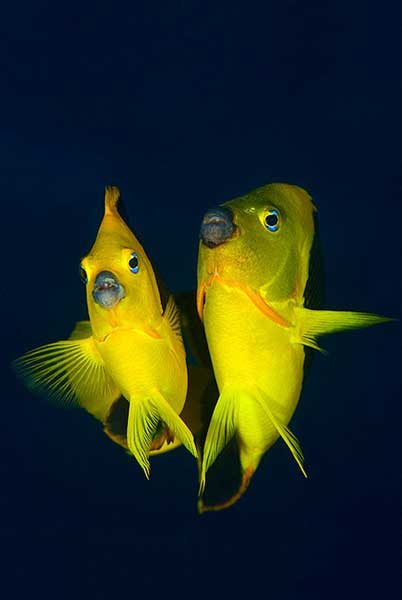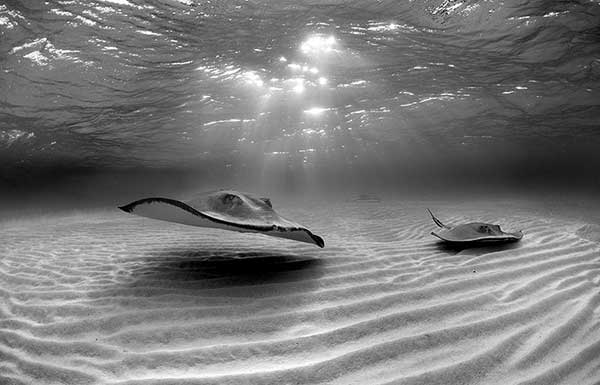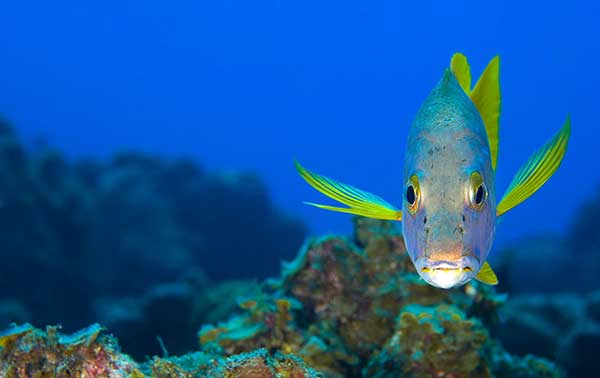

 |
 |
 |
 |
 |
We are trying to develop a community where photographers can come and discuss nature, wildlife and pet photography related matters. We encourage you to enter the forums to share, make comments or ask questions about this interview or any other content of NWP.
This interview is Copyright 2006, James Morrissey, and may not, in part or in whole, be reproduced in any electronic or printed medium without prior permission from the author. The images in this article are the property of Alex Mustard and have been licensed to James Morrissey and the NWP Photo Forum for the purpose of this interview.

A male rock beauty angelfish (right) circles a female during courtship, Cayman Islands. © Alexander Mustard/amustard.com. Nikon D2X + Nikon 105mm micro. F6.3 @ 1/250th. 2 x underwater strobes.
Part II: The Business Aspect of Photography
JM: Please describe what your business looks like currently - what do most of your photographic sources of income lead from?
AM: Like many wildlife photographers, my business consists of multiple income streams. First, the bulk of my income comes from selling images both for advertising and editorial, plus writing illustrated articles and of course in the last year the book, which I know we’ll talk about later. Second, there are group trips I run. I try to do just 1 photo workshop a year, I actually really love teaching but I certainly remain a photographer first. By limiting myself to one or two a year I can make sure we put on a really special event that stands out from the others that are on offer. This means that my trips fill up fast and are profitable without being overpriced. I also run a couple of wildlife group trips a year – where the focus is on the creatures, although most people are photographers. These trips exploit my marine biological expertise, and are much more relaxing than teaching photography. Also, last year, I developed a filter that allows underwater photographers to take colourful images without flashguns. This filter called the Magic Filter also contributes a steady, if not massive, monthly income. And finally on top of that I have various earnings from my marine biology.
JM: Let's talk a bit about the Magic Filter.
AM: The Magic Filter is great - and it is transforming underwater photography. Underwater light is blue and traditionally we always use flashes or strobes to get colourful shots. The Magic Filter is designed to allow us to create full colour images without the need for strobes, by working with the white balance of a digital camera to counteract this blue lighting. It is not a replacement for shooting with flashes or strobes. Instead it is an alternative technique - one that allows photographers to create new types of images under the right conditions. I still shoot 8 out of 10 dives with strobes, and use the filter to add new types of images to my portfolio. I am very proud that underwater photographer Rand McMeins won Best Of Show and The David Doubilet Award for excellence in underwater photography at the recent Beneath The Sea festival with an image taken with the filter. The naturalistic look of Magic filter shots has made them very desirable for publication. Magic images (not including those taken by me) have been published in many magazines now and have been used in a couple of international advertising campaigns. The Magic Filter was also used to take many of the images in the new PADI Digital Underwater Photographer specialty course materials. [What is amazing is that] it hasn't even been on sale for a year yet! One of the biggest decisions with the filter was to decide the price. In the end we went for as low a price as we could. Anyone who has ever had a custom filter made for them will soon realize that we don't make much from the filters, considering our prices include international postage. The plus side of the low price is that it has encouraged people to try the technique and made filter photography popular. The real payback for me has been that the filter has really increased my profile. You can see more at www.magic -filters.com
JM: When was the first time you were published? How long did it take you from your first photographs to become regularly published?
AM: More than 10 years! I started shooting underwater when I was in single figures and I didn’t really see my images published until I was at university! But really until the last few years my photography has always been about personal satisfaction rather than being published. I guess when I went pro I just changed the point of satisfaction from seeing a good image myself to seeing in press.
JM: How did you go about approaching the magazines and other publishers when you were†first starting?
AM: I have never been a big salesman of my own work. The underwater media industry is small and I just appeared on their radar by winning competitions etc. Then they came to me, and nearly all the editorial stuff I do is because people come to me, asking me to write about this or submit a set of images for that. Competitions worked well for me because they provide a good way to getting your name known, but you have to enter the important ones as these are the ones the publishers pay attention too.

Stingrays over ripples at dusk, Cayman Islands. © Alexander Mustard/Oceans-Image.com. Nikon D2X + Nikon 10.5mm fisheye. F5.6 @ 1/125th.
JM: Do you feel that the secret of your success has been the milieu that you work in?† i.e. the world is filled with Wildlife photographers who photograph on land but the world of under-water photographers makes it easier to break in?
AM: Of course there are far less underwater photographers. But I also think that the market for underwater images is smaller too.
In any field the world needs more than one photographer’s eye - so there is always the chance to break in. It is like music - I don't want to listen to Coldplay all the time. I want to listen to other bands and other styles of music. There is always room for more photographers as long as they are adding something new. Just being a clone of an existing photographer is not going to get you a big break.
JM: How would you recommend this today?
AM: I’d start by saying that I am new to this game and I’m sure I am not the best person to ask. But I believe that there are two important factors to working in editorial. One is to offer the publishers something they don’t have already. There is no point in thinking my shots are as good as staff photographer X so the magazine should publish my shots too. You have to ask yourself why would they want your shots when they already have someone they know and trust who can do those shots for them? So you have to offer them something different or better than what they have already. Ideally both.
Even more important is to develop a good business relationship with them. ALWAYS deliver text and images before deadlines. Be helpful and don’t be a pain. Get a reputation for delivering high quality material on time and without any hassle for them and they will want to run your work all the time. All magazines have stories of a fantastic photographer who they now refuse to work with now because he made them miss a deadline.
Part of this relationship is to ask them what they want. Listen and then follow their advice and give them exactly what they asked for. On many occasions I will ring an editor for a 5 minute chat while preparing a piece – and ask him or her what they want. I then do what they tell me – and low and behold when I submit the piece they write back saying “Wow, it is exactly what they wanted” and it goes off to press.
JM: Let's talk about your new book. What kind of work did it take to get it published?
AM: To start at the beginning. The book is called The Art Of Diving and is a collaboration with author Nick Hanna, published by Ultimate Sports in the UK. Nick, a professional writer, had seen my work and approached me initially about doing a feature together for The Times (London), with the possibility of developing it into a book. The concept for the book took a couple of iterations, but once we got it right, it was signed up by the first publisher we approached. It is Nick’s 16th or 17th book, so his experience was a great benefit to me throughout. A few people have commented that it is unusual to have a book by two people, but it made perfect sense to me. As a marine biologist I would always collaborate with physical oceanographers to solve complex questions about ecosystems that I couldn’t solve on my own. It just made perfect sense to me to combine our skills.
JM: Was your collaboration on The Art of Diving regulated to photography or were you involved in writing as well?
AM: The Art Of Diving was a true collaboration between the writer Nick Hanna and I. I had a great deal of input into what subjects the text covered and who was interviewed and which books were referenced etc. Nick also had many suggestions for my images and of course appears in quite a few! I should stress that Nick wrote all the words and I did all the colouring within the book!
JM: What are your favorite aspects of your new book?
AM: I love that the book is about scuba diving. It is an introduction to what scuba diving has become since Cousteau started it all, the experience of being underwater and the diversity of adventures that divers enjoy and why divers find it so addictive. Our intention was always for it to have a broad appeal, and early sales are very encouraging – we even made the top 250 best sellers on Amazon (UK), which is an amazing achievement for an underwater book. From a photographic point of view I wanted to give the image selection a strong sense of coherence as a collection. I tried to shoot in a specific style to create an overall that made the underwater world look bright, colourful and inviting. I hope that the pictures remind divers of great times underwater and make non-divers want to give it a go. The underwater world lends itself to moody, mysterious lighting, but this is something I chose to avoid and rejected several of my images for this reason. Anyway you can see more at http://www.artofdiving.com
JM: What do you feel that the key pieces for running a successful photographic business are? What do you believe are specific recipees for failure?
AM: I don’t believe that a photography business is so different from any other. First you need a good product. That means good shots that are different and justify a place in the market. Then you need a good distribution – basically being organized to get images to customers to meet their deadlines. You also need some degree of advertising for your images, to increase their desirability. With photos that is usually linked to the profile of the photographer – although this doesn’t necessarily mean public profile. What matters is your profile in the eyes of your clients. Finally you must be prepared to work hard to make any business successful.
JM: Are there any resources for people just trying to get into publishing and other forms of professional photography that you feel are helpful?
AM: Not that I know, but then I am very new at this game. I have found that face time with potential clients is always invaluable. Talking to editors at trade shows, asking them what they want. Get it straight from the horse’s mouth. Find out what they want and then give it to them.

Schoolmaster portrait over reef, Cayman Islands. © Alexander Mustard/Oceans-Image.com. Nikon D2X + Sigma 28-70mm. F7.1 @ 1/160th. 2 x underwater strobes.
JM: When you first decided to make the photographic world a business as well as a hobby, what sort of business plan did you develop in order to insure that you would be able to afford to keep your standard of living?
AM: Every wildlife/nature/underwater photographer will tell you that you that there is no money in this game. While that is not entirely true, you are unlikely to get your hands on it immediately. So I made a business plan that would allow me to survive on minimal income initially. Also before leaving my salaried employment I made sure I had lined up clients for my first few months and had purposely saved up some money to live on.
Cash flow is another early problem, as the big pay-days tend to be sporadic and unpredictable. I try to generate as many regular monthly income streams as I can. Small but reliable income can be very useful. Writing monthly articles, columns and filter sales all help me in this respect. It is now two years since I started and I have a pretty good feeling for my income over the next 6 months or so, which makes budgeting easier.
Another important area for me is to reduce overheads. Travel, diving, equipment are all expensive. If I can reduce or eliminate these costs that allows me to turn images more quickly into profit. But there is no such thing as a free lunch – and generally free stuff always comes with conditions. These days I actually prefer to be a paying customer when I can afford it. You can be much more of a pain that way, which is usually a benefit when you just need another 20 minutes to get the perfect light!
JM: Is what you are doing today remotely similar to what you had planned? If not, why?
AM: I thought I’d be doing more science than I am. But it just seems that people prefer me being a photographer (or maybe they just didn’t like me being a scientist!). I love the short deadlines and the diversity of projects that come my way as a photographer. The very short turn around time of publishing these days makes it very exciting work. The downsides are that I also work a lot more hours than I had ever planned, and being self employed I do have the common problem that it is hard to stop work and switch off. Much to my girlfriend’s displeasure!
JM: What experience do you have selling stock photography, if any?
AM: This is certainly one of my failures. I do have pictures in libraries, but stock doesn’t really seem to work for me. I think that my style is not the best suited to stock. And maybe I should try some different libraries. Sorting this out has been on my to do list for some time, although I am not sure how.
JM: How does your website play into your business?
AM: A website is a great tool for the photographer. It combines a business card, resume and portfolio in one go. The conundrum I find is trying to decide how many images to put on there, about a year ago there weren’t enough, now there are too many. I like to give an overall impression of my work, but it is also nice to have a good number of first class images offline that haven’t been seen and remain fresh. I think people like fresh content on websites – so if you are going to have a complicated one, make sure you have resources to keep it up to date. I also use the website for sharing private galleries with potential clients – it is just a quick as emailing over a load of jpgs, but I think that people like to be able to see a private gallery created just for them.
If you are interested in learning more about Alex Mustard, you can visit: www.amustard.com.
As always, we encourage you to come join the community and to be participants in the forums! If you have not yet registered, please
 |
 |
 |
 |